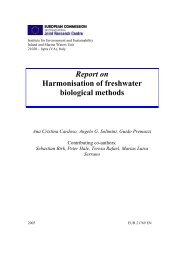Lakes and Watercourses
Lakes and Watercourses
Lakes and Watercourses
You also want an ePaper? Increase the reach of your titles
YUMPU automatically turns print PDFs into web optimized ePapers that Google loves.
very high degree of reliability <strong>and</strong> at a much lower cost than previously.<br />
Analyses of metals in aquatic moss (Fontinalis antipyretica <strong>and</strong> F. dalecarlia)<br />
can be used as an indirect measure of concentrations in water. Moss<br />
growing locally as well as planted specimens can be used. Concentrations<br />
in aquatic moss reflect metal concentrations in water over a lengthy<br />
period (weeks) <strong>and</strong> are an effective means of surveying sources <strong>and</strong> the<br />
size of contaminated areas <strong>and</strong> can also be used to gain an idea of the<br />
level of pollution in the aquatic area. However, absorption of metals by<br />
aquatic moss is not dependent merely on the concentration in water;<br />
acidity, for example is another factor. This limits the utility of the<br />
method, particularly in acidified waters.<br />
Concentrations of metals in sediment provide a good picture of the<br />
influx of metals into an aquatic area. Sampling procedures <strong>and</strong> analyses<br />
are fairly simple <strong>and</strong> reliable <strong>and</strong> analyses of sediment are therefore<br />
highly suitable for surveying the impact of metals, for example. By<br />
analysing deeper sediment strata it is possible to extrapolate the time<br />
trend for load backwards in time <strong>and</strong> to determine original metal concentrations<br />
in the aquatic area.<br />
Concentrations of mercury in fish mainly serve to provide a basis for<br />
assessing the risks to humans of eating fish. Metal concentrations in fish<br />
are also a useful means of evaluating the risk of damage to mammals <strong>and</strong><br />
birds whose diet mainly consists of fish.<br />
Assessment of current conditions<br />
TABLE 18.<br />
CURRENT CONDITIONS: metals in water (µg/l)<br />
Class Description Cu 1) Zn Cd Pb Cr Ni As<br />
1 Very low conc. ≤ 0.5 ≤ 5 ≤ 0.01 ≤ 0.2 ≤ 0.3 ≤ 0.7 ≤ 0.4<br />
2 Low conc. 0.5 – 3 5 – 20 0.01 – 0.1 0.2 – 1 0.3 – 5 0.7 – 15 0.4 – 5<br />
3 Mod. high conc. 3 – 9 20 – 60 0.1 – 0.3 1 – 3 5 – 15 15 – 45 5 – 15<br />
4 High conc. 9 – 45 60 – 300 0.3 – 1.5 3 – 15 15 – 75 45 – 225 15 – 75<br />
5 Very high conc. >45 >300 >1.5 >15 >75 >225 >75<br />
1) These values apply particularly to lakes <strong>and</strong> streams. Background concentrations are often higher in<br />
larger watercourses; concentrations of up to 3 µg/l are not uncommon. The boundary between class<br />
1 <strong>and</strong> 2 has been set on the basis of the 75th percentile for northern Swedish streams <strong>and</strong> lakes.<br />
The following may be said of the risk of biological effects caused by<br />
metals in concentrations corresponding to the various classes:<br />
42















![Accommodation booking form [PDF]](https://img.yumpu.com/39471785/1/184x260/accommodation-booking-form-pdf.jpg?quality=85)

